![]()
![]()
![]()
Use LEFT and RIGHT arrow keys to navigate between flashcards;
Use UP and DOWN arrow keys to flip the card;
H to show hint;
A reads text to speech;
49 Cards in this Set
- Front
- Back
|
Consecutive |
Numbers in order |
|
|
Difference |
Substract one number from another |
|
|
Digit |
A number from 0 to 9. 376 is a three-digit number. |
|
|
Distinct |
Different (the distinct factors of 4 are 1,4,2- not 1,4,2,2 |
|
|
Factor |
Same meaning as "division"; a smaller number that goes into your number. |
|
|
Multiple |
A bigger number that your number goes into (8 is a multiple of 2) |
|
|
PENDAS |
Parentheses, exponents, multiplication, division, addition, substraction. |
|
|
Places |
In 234.167, 2 is in the hundreds place, 3 is in the tens place, 4 is in the ones or units place, 1 is in the tenths places, 6 is in the hundredths place, and 7 is in the thousandths places. |
|
|
Product |
When you multiple two numbers together. |
|
|
Quotient |
What you get after dividing one number into another. |
|
|
Reciprocal |
Whatever you multiply a number by to get 1 (reciprocal of 1/2 is 2/1. Reciprocal of 6 is 1/6) |
|
|
Remainder |
What's left over if a division problem doesn't work out evenly. |
|
|
Sum |
What you get when you add two numbers together. |
|
|
To add fractions |
Get a common denominator and then add across the top. 1/2 +2/3=3/6 + 4/6= 7/6 |
|
|
To substract fractions |
Get common denominator and then substract across the top 3/4- 1/3= 9/12- 4/12= 5/12 |
|
|
To multiply fractions |
Cancel if you can, then multiply across, top and bottom. 1/2× 3/5= 3/10 2/7× 14/19= 2/1× 2/19= 4/19 |
|
|
To devide fractions |
Flip the second one around, then multiply across, top and bottom. 2/3÷ 1/2= 2/3× 2/1= 4/3 |
|
|
To see which of two fractions is bigger |
Cross- multiply from bottom to top. The side with the bigger product is the bigger fraction. |
|
|
To convert a fraction to a decimal |
Use a calculator to divide the numerator by the denominator. |
|
|
To convert a decimal to a fraction |
Count up the number of digits to the right of the decimal point, and put that many zeros in you denominator. 0.2= 2/10 .314= 314/1000 2.23= 223/100 |
|
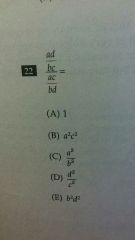
Dividing fractions |
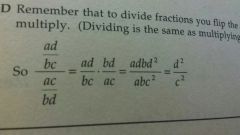
Remember that to divide fractions you flip the denominator and multiply |
|
|
To convert a percent to a decimal |
Move the decimal point two spaces to the left 50%= .5 4%= 0.4 .03%= .0003 112%= 1.12 |
|
|
To convert a decimal to a percent |
Move the decimal point two spaces to the right .5= 50% .66= 66% 0.1= 1% 4= 400% |
|
|
To convert a percent to a fraction |
Put the number over 100 50%= 50/100 4%= 4/100 106%= 106/100 x= x/100 |
|
|
To get a percent of a number |
Multiply by the decimal. So to get 22% of 50, first change the percentage to a decimal by moving the decimal point two places to the left= .22. Then multiply on your calculator. .22 × 50= 11 |
|
|
To get a percent of a number (pt. 2) |
The second way to get a percent of a number is to transform you sentence into an equation. This is easier than it sounds. Convert the percent to a fraction and substitute × for of, = for is, and x for what What is 50% of 16? X=50/100 × 16 What is 10% of 40% of 22? X= 10/100 × 40/100 × 22 |
|
|
To calculate what percent one number is of another number |
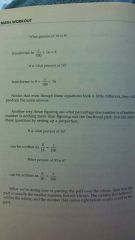
Use the tranformation method, substituting x/100 for what percent |
|
|
To calucate percent increase or decrease |
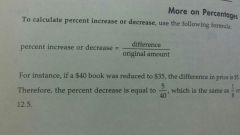
|
|
|
To figure the actual numbers in a ratio |
Add the numbers in the ratio and divide into the total. Take that number and multiply by both parts |
|
|
Ratios |
A ratio is like a percentage- it tells you how much you have of one thing compared to how much you have of another thing. If you have hats and t-shirts in a ratio on 2:3, then for every two hats you have three t-shirts. What we don't know is the actual number of each. It could be two hats and three shirts. Or 4 hats and 6 shirts. Or 20 hats and 30 shirts |
|
|
To get the average (arithmetic mean) of a set of numbers |
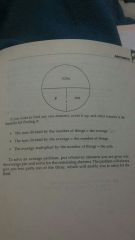
Add them up, then devide by the number of things in the set |
|
|
To find the median |
First put the group of numbers in ascending order. If the group has an odd number of elements, the median is the middle number. Of a group has an even number of elements, the median is the average (arithmetic mean) of the two middle numbers. |
|
|
To find the mode |
Just look to see which number in the group appears the most often. |
|
|
To multiply exponents with the same base |
X^2 × X^5 = X^(2+5) = X^7 |
|
|
To divide exponents with the same base |
Substract the exponents X^6 ÷ X^3 = X ^(6-3) = X ^3 |
|
|
To raise the power of exponents with the same base |
Multiply: (X^4)^3 = X^(4×3) = X^12 |
|
|
For exponents with the same base |
You cannot add or substract different exponents X^6 + X^3 is just X^6 + X^3 You can't reduce it. |
|
|
For exponents with different bases |
You can't do anything to it. Don't try to multiply, divide, add, substract, or cancel. |
|
|
To deal with exponents and parentheses |
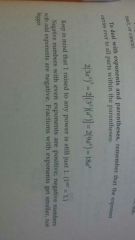
Remember that the exponent carries over to all parts within the parentheses. |
|
|
Roots |
A square root is just a backwards exponent. In other words, the number under the square root sign is what you get when you raise a number to the power of 2. |
|
|
To multiply or devide by square roots |
Just multiply or devide by usual. Square root of 7 × square root of 3 = the square root of 21. Square root of 15 ÷ square root of 3 = square root of 5. |
|
|
To add or substract square roots |
First make sure you have the same number under the square root sign. Then add or substract the number outside the square root sign. 5 × square root of 3 + 2 × square root of 3 = 7 × square root of 3 6 × square root of 2 - square root of 2 = 5 × square root of 2 |
|
|
The square root of a fraction |
Gets bigger |
|
|
The square root of a number |
Is always positive |
|
|
The square root of 1 |
Is 1 |
|
|
Distance |
Distance = rate × time Rate = distance ÷ time Time = distance ÷ rate |
|
|
Sine of angle |
Pick length of opposite of angle and the length of the hypotenuse forming a ratio |
|
|
Slope |
Y1 - Y2 ÷ X1 - X2 |
|
|
Foil |
Firsts, outside, inside, lasts |

